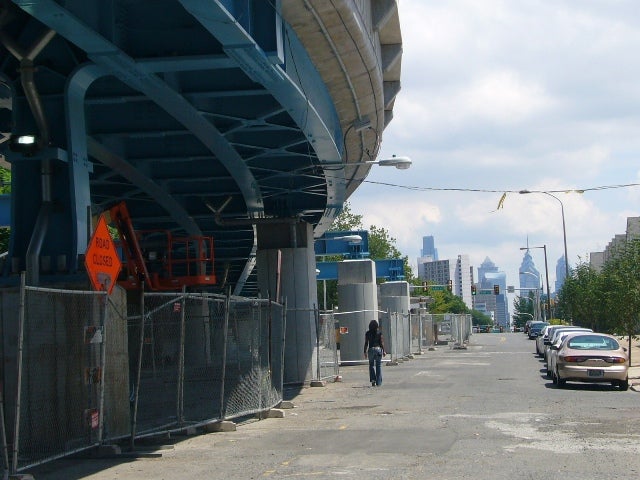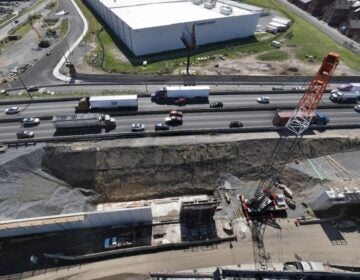Transit Oriented Design push in Philadelphia

July 24
Previous TOD coverage:
Building for transit based living
Encouraging transit oriented development
By Seth Budick
For PlanPhilly
“The nucleus of the neighborhood.” It’s a phrase that was repeated several times last night at a community meeting to discuss the plans for transit-oriented development (TOD) at the 46th Street station of SEPTA’s Market-Frankford Line. At The Enterprise Center, the onetime home of Dick Clark and American Bandstand, West Philadelphia residents heard how planners envision the station becoming the center of a walkable and transit friendly neighborhood.
The 46th St. station is the focus of one of two transit-oriented development projects in Philadelphia that has received Transit Revitalization Investment District funds from the state to develop a TRID planning study. The TRID planning process has been managed by the non-profit, NeighborhoodsNow, which selected a team including Interface Studio to create the TRID plan.
As development consultant Lamar Wilson explained in his introduction to the meeting, developing a TRID planning study requires holding sessions with community members in order to seek out their ideas, suggestions, and priorities. Wilson was also up front about the need to consider funding realities saying “it makes no sense to talk about ideas, projects, and programs unless there are resources to make those things reality. No one wants to spin their wheels.”
Scott Page, Principal at Interface Studio, then spent the bulk of the meeting outlining what he called a “range of ideas” rather than a plan since, as he put it, “we haven’t had your buy-in, we haven’t had you say ‘that’s a great idea.’” Interface started its work in December with the intention of incorporating community feedback into a plan that the neighborhood will have a chance to examine and comment on. The final plan will then be completed in the next month or two, he said.
Page explained that this TRID study actually covers two stations, the 46th St. station and the Temple University station on the Regional Rail, but only the 46th St. portion was presented last night. Being one of the first TRIDs in the city, the 46th St. station has a great opportunity to set a precedent for TOD, Page said. “You can potentially be a model for the rest of the city. And if the state decides to enact these TRIDs, that means that there’s potential money coming to the neighborhoods around these stations. The fact that you’re first, the fact that we’re doing this planning, is significant and is a big benefit to all of you.”
So why focus on transit? Page answered his own question by saying that 60% of the city’s population drives to work and that transportation is the second largest household cost after housing. The goal of TOD therefore is largely to provide alternative modes of transportation and one of the main objectives of this TRID plan is to answer the question, “What can we do to make transit more friendly and accessible?”
Page then listed some of the defining features of TOD, but not before saying that in other cities, he doesn’t usually need to explain the concept. When it comes to TOD, “Philadelphia’s a little bit behind the curve,” he said. Page explained that TOD is about encouraging moderate density housing around transit stations; densities between townhouses and 4, 5, or 6 story buildings. Another important component of TOD, he said, is a mixture of uses (housing, office, and retail) as well as mixed-income housing.
For the TRID, Interface Studio was asked to consider the area within a half-mile radius of the station, ranging roughly from Brown St. to Pine St. and 41st St. to 51st St. They found that while 25,000 people per day within that radius could be taking transit, only 7% presently do. “We’re not trying to be unrealistic and say 50% of the people in the neighborhood should take transit, but if you can increase that 7% to 15%, you would see a lot less cars on the road,” Page said.
So what’s preventing people from using the station? There are a couple of key issues that were raised in previous community meetings, with crime, both real and perceived, being the clear number one issue, according to Page. Trash, poor lighting, deteriorated sidewalks, and building vacancy also showed up high on lists generated by community members. Interface also considered major barriers to the station, including Chestnut St., which is used by 19,000 cars per day and is dominated by auto oriented uses in that neighborhood. “We’re missing some density, we’re missing housing, we’re missing what makes a neighborhood a neighborhood, in some places,” as Page put it. “Anyone who’s lived here a long time told us that this neighborhood used to be solid; more housing, retail on Market St. We’re trying to basically rediscover what the neighborhood used to be.”
Page then outlined a set of recommendations for making the 46th St. station TRID into a transit friendly community. First among these was creating a clean and safe environment around the station, including improvements like sidewalk lighting and stepped-up street cleaning. Page was then joined by Frank Jaskiewicz, a transportation planner who has been working on the transportation aspects of the TRID plan.
Among his recommendations, Jaskiewicz also stressed the importance of security, which could include improvements like security cameras. He also mentioned a variety of train and bus station changes, from automated announcements of upcoming train arrivals, to simply posting bus maps and schedules in new bus shelters. Jaskiewicz also stressed the importance of safe facilities for bike parking at stations since “bicycles can extend the range of the station itself.”
Jaskiewicz also brought up the possibility of reengineering some of the nearby intersections which currently serve as substantial barriers for pedestrians, such as those on Chestnut St. “A lot of the streets are holdovers from the time in the 60’s and 70’s when the main concern of transportation planners was to get cars through as quickly as possible,” he said. He also suggested that we can learn a lot from more walkable streets by narrowing intersections and widening sidewalks. When it came to parking, Jaskiewicz stressed that 46th St. station serves the neighborhood, rather than functioning as a park and ride; parking for cars from outside of the immediate area should therefore be limited.
Page then made several suggestions for increasing green space in the area since part of becoming a transit friendly neighborhood means encouraging people to leave their cars for a variety of reasons. One idea was for a new park in a vacant lot adjacent to the station which would create visibility for the station as well as improving access, particularly if it extended all the way to Chestnut St. In one of their more creative moves, Interface also suggested adding a running track around edge of the “superblock” that currently extends between Market St. and Haverford Ave. between 46th St, and 48th St. Other green space in the neighborhood could act as “rain gardens” absorbing water instead of generating runoff that could otherwise flood basements or pollute waterways.
Finally, Page broached the topic that many people probably think of immediately when they hear about TOD: development. Instead of talking about specific projects though, Page mostly emphasized the work that Interface has done to identify sites on local streets that represent strong development opportunities as the El reconstruction nears its completion.
He did, however, mention Enterprise Heights, a mixed use project at the corner of Market St. and Farragut St. which should break ground in early 2009, according to Omowale Crenshaw, Director of the Enterprise Heights Real Estate Development Company. One other specific opportunity that Page mentioned is the possibility of new streets, and the accompanying development, in that superblock adjacent to the station and north of Market Street. Finally, Page also mentioned the lot directly across from the station which is currently occupied by the Aldi market but which otherwise sits in a sea of parking. Page suggested that a new supermarket integrated with housing would be something that’s a lot more walkable and transit friendly.
Following the presentation, the audience broke up into smaller groups to give their feedback and prioritize those possibilities mentioned by the planners. Many in attendance seemed pleased with the overall direction of the plan, but voiced their concerns about some of the specifics. Lilian, a longtime neighborhood resident, was concerned about the possibility of rising property taxes as a result of new development, even though those funds would be specifically targeted for the TRID. She also addressed the issue of safety in accessing the station and said that she rides the bus instead, specifically because of concerns about crime and poor lighting.
When another attendee made the point that newly greened neighborhoods are great, but they need someone to maintain those plantings, Francis, a Wynnefield resident who grew up in the neighborhood suggested that this might be a perfect project for neighborhood youth. Her suggestion that “if we teach the young people how to landscape, we can maintain all this” was greeted with nods all around the group.
As a final step, audience members placed colored stickers on a map of the neighborhood to indicate their priorities for the TRID plan. Interpreting those maps and incorporating those suggestions will be the next step for the planning team as they attempt to meet their ambitious goals. As Page said “We want to make this a model for Philadelphia, a model that politicians can look to and say ‘this is a great idea, we should be funding these types of improvements around stations, look what it’s doing to this community.’”
Contact the reporter at sbudick@gmail.com
WHYY is your source for fact-based, in-depth journalism and information. As a nonprofit organization, we rely on financial support from readers like you. Please give today.






